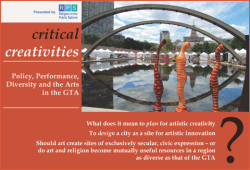
RPS Community Research Workshop "Critical Creativities: Policy, Performance, Diversity, and the Arts in the GTA "
Date and time
Location
170 St George Street
Room 318 Toronto, ON M5R 2M8 CanadaDescription

Later the same day, from 5:30 to 7:30, Thursday 23 October, we are holding the RPS Public Forum with visual artist Jamelie Hassan, dancer and dance teacher Melissa Noventa, and performing artist and educator Sashar Zarif .
Entry to the forum is by ticket only: click here to get your tickets
Our Community Research workshop brings together scholars, students, policy-makers and artists to discuss specific policy issues related to art, diversity, and youth in the city.
Presenters:
- Anne Frost (Experienced theatre administrator; Director, Arts Administration & Cultural Management Program, Humber College)
www.humber.ca/scapa/people/anne-frost - Gita Hashemi (Artist, curator, writer)
gitaha.net - Sheniz Janmohamed (Poet, author, spoken word artist and freelance writer)
shenizjanmohamed.com - Newton Moraes (Newton Moraes Dance Theatre: Director, Choreographer, Performer, Founder and Researcher)
www.newtonmoraesdancetheatre.com
- Waleed Abdulhamid (Multi-instrumentalist, composer, vocalist, producer and film-maker, School of Creative & Performing Arts, Humber College)
www.humber.ca/scapa/people/waleed-abdulhamid - Graeme MacQueen (Retired faculty member, Religious Studies, McMaster. Founder, Centre of Peace Studies, McMaster)
www.hpl.ca/people/macqueen-graeme - Kwanza Msingwana (Writer, actor, storyteller)
www.cobainc.com/bios.php?bio=kwanza_msingwana - Vivine Scarlett (Programme Director and Curator, Dance Immersion)
www.danceimmersion.ca
What does it mean to plan for artistic creativity, or to design a city as a site for artistic innovation? How do we trace the blockages as well as the flows between planning and performance? And what about wider cultural questions?: Should art create sites of exclusively secular, civic expression, or do art and religion become mutually useful resources in a region as diverse as that of the GTA? These are some of the questions that drive these RPS Community Research Workshop (day) and Forum (evening) events on Thursday 23 October. They indicate the critical importance of creativity in the production and performance of engaging urban space. But they are also meant to take a critical look at the very idea of creativity as a generic form of cultural capital.
For their kind support of this event, we would like to extend our thanks to the Religious Diversity Youth Leadership Project, Cultural Pluralism in the Arts Movement Ontario (CPAMO), and the Department for the Study of Religion.
A closer look...
It is 2014. The Toronto and District School Board launches its first annual Dare2Create Arts Festival, encouraging youth to spread art around the city. Newspapers debate the merits of U of Toronto Professor Richard Florida’s ‘Bohemian Index’ as a way of assessing the creative potential of urban spaces. Meanwhile, popular philosopher Alain de Botton turns up to plug his book Art as Therapy, which is also being turned into an exhibition at the Art Gallery of Ontario. All of this activity recalls Charles Landry’s notion of the ‘creative city’, a term he hoped would initiate a new planning paradigm for metropolitan living.
But what does it mean to plan for artistic creativity, or to design a city as a site for artistic innovation? How do we trace the blockages as well as the flows between planning and performance? And what about wider cultural questions?: Should art create sites of exclusively secular, civic expression, or do art and religion become mutually useful resources in a region as diverse as that of the GTA? These are some of the questions that drive these Religion in the Public Sphere Forum and Community Research Workshop events. They indicate the critical importance of creativity in the production and performance of engaging urban space. But they are also meant to take a critical look at the very idea of creativity as a generic form of cultural capital.
Such debates have a significant history in the GTA. In 1986 Toronto became the first Canadian municipality to develop strategies aimed at encouraging public art in major building projects. In 2007, the city implemented the ‘Percent for Public Art’ policy, encouraging construction firms to donate one percent of the budget to artistic work. A recent ‘Creative City Planning Framework’ presents arts policy as contributing to a Toronto that is (as ever) ‘on the cusp of becoming a world city’, and highlights the need to engage young people though producing and attending cultural events. But does ‘public’ art include—or create—some publics while excluding others? How does ‘the public’ relate to ‘the plural’ whether in terms of generation, class, religion, or gender? And will arts policy have any relevance to current political debates that highlight cleavages in political and cultural vision between ‘inner’ downtown core and ‘outer’ suburb, city and GTA, urban and rural?
We invite you to explore the creative boundaries between religion and the arts, public and private funding, high-profile projects and local community expressions. Our evening public forum panel features researchers, policy-makers, and artists who will provide short presentations, engage in mutual discussion and respond to questions from anybody who wishes to attend. Earlier in the day, our Community Research workshop brings together scholars, students, policy-makers and artists to discuss specific policy issues related to art, diversity, and youth in the city.
Organized by
Examining how religion manifests in public spaces, institutions, and interactions, and considering the challenges and possibilities of religious diversity in Toronto and around the globe.